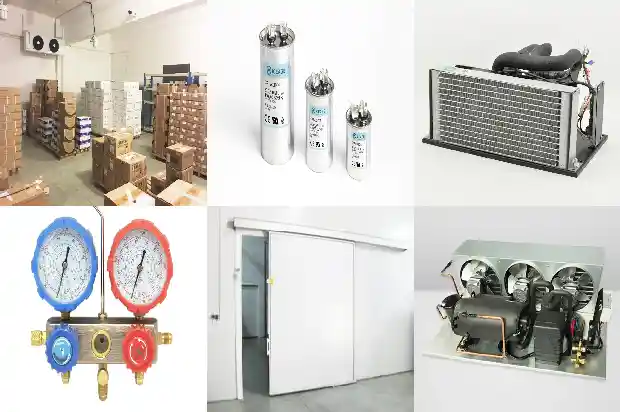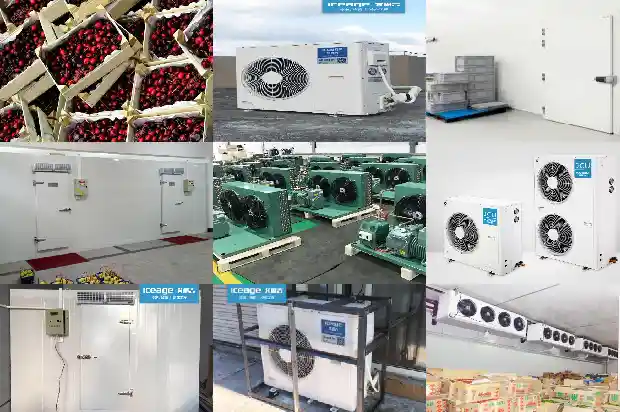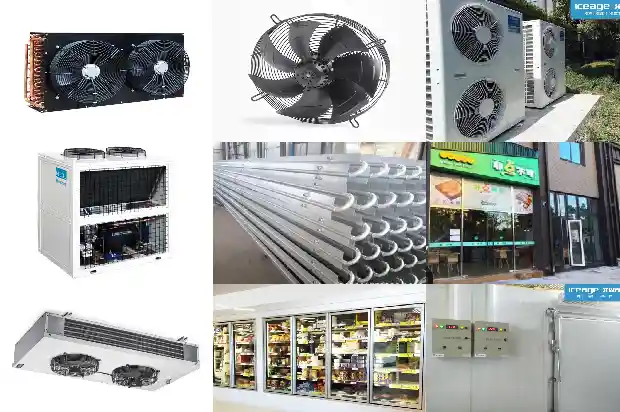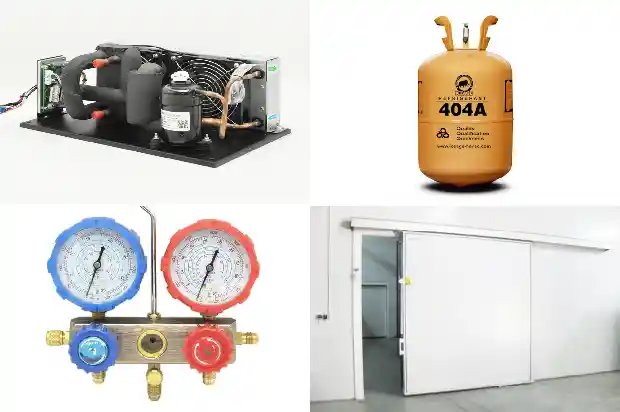Structural Components of Centrifugal Compressor
2024-09-16
- Refrigerant:
The refrigerant, also known as coolant, is generally Freon in air conditioners. When the refrigerant evaporates (just like boiling water requires heat), it needs to absorb the heat in the air conditioning chilled water system, thus achieving refrigeration. - Cycle:
Refrigerant vapor from the evaporator flows into the compressor. After being pressurized and heated by the screw compressor, it is discharged into the oil separator. Oil is separated before the high-pressure gas flows into the heat exchange tube bundle of the condenser. The cooling water in the condenser absorbs the heat of the refrigerant vapor to cool and condense it. The cooling water is provided by an external water source, generally a cooling tower. The condensed refrigerant liquid enters the liquid pipeline from the condenser, and the refrigerant supply to the evaporator is controlled by the throttling device (consisting of a fixed orifice plate and a solenoid valve) inside, thus completing the entire refrigerant cycle. - Tightness of refrigerant system:
The infiltration of air into the refrigerant contains moisture. During the refrigerant flash process, ice blockage will occur, resulting in insufficient refrigerant flow for cooling the motor. - Compressor:
The low-pressure and low-temperature refrigerant gas in the evaporator needs to be driven by a motor at high speed. The compressor and the motor are separated.
There is a reliable seal and connection between them. The motor is cooled by air. The compressor is a positive displacement, direct-start, twin-screw rotor twin-screw compressor. The motor directly drives the male rotor, and the female rotor is driven by the male rotor. The rotors and the compressor housing do not contact each other. The rotors are separated by pressure-sealed oil seals. This oil seal can prevent high-pressure gas from leaking to the low-pressure area.
- Spool valve:
The spool valve is used for stepless control of capacity (from 100% to 15% precision control). When starting up again after normal shutdown, this component is not loaded. The spool valve is controlled by a micro control board through oil pressure.
Function: Cooling capacity control is achieved by pushing the spool valve with pressure difference. - Control:
The spool valve adjusts the compressor displacement by axial movement between the compressor and the screw to meet the needs of the system. The spool valve mechanism in the screw compressor adjusts the unit capacity according to various working conditions.
The spool valve mechanism is controlled by the control center and control components that detect working conditions. The control center sends signals to the solenoid valve and uses compressor lubricating oil to load or unload the spool valve hydraulically. A spring-preloaded shaft and piston (live valve) are placed in the spool valve cylinder at the end of the compressor. The spool valve moves in the cavity by the thrust of high-pressure lubricating oil. High-pressure end lubricating oil flows in through the oil supply hole on the piston. The flow of lubricating oil is controlled by the equilibrium solenoid valve.
The solenoid valve adjusts the loading or unloading of the spool valve, thereby increasing or decreasing the refrigerant flow entering the compressor and finally controlling the capacity of the unit.
- Chilled water unit system:
It consists of several parts, including the main unit, terminals and peripheral equipment. The main unit is responsible for providing 7-degree chilled water to the terminal equipment. The terminal uses the chilled water provided by the chilled water unit and filtering devices to process the air that needs to be sent to the air-conditioned room to an appropriate temperature, humidity, cleanliness and fresh air ratio. Peripheral equipment includes water pumps and cooling towers. The water pumps are responsible for transporting chilled water and cooling water. Chilled water is 7-degree chilled water.
Cooling water takes away the heat generated during the refrigeration process of the system, exchanges heat and cools with air in the cooling tower, and then returns to the condenser.
- Oil separator:
The oil separator separates the oil injected into the compressor by gravity and filter screen to separate the vapor/oil before it enters the condenser. The oil separator is a three-stage oil separation type:
First-stage separation: In the first stage of oil separation, as soon as the high-speed mixture of refrigerant and oil enters the large-diameter oil separator, the speed quickly decreases. Most of the oil can be separated from the refrigerant gas flow due to the reduced speed. The separated oil falls into the oil sump at the bottom of the oil separator due to gravity.
Second-stage separation: In the second stage of oil separation, it is completed by the refrigerant gas directly passing through the filter screen with an enlarged surface. Small oil droplets gather on the surface of the filter screen and then fall into the oil sump at the bottom of the oil separator due to gravity.
Third-stage separation: In the third and final stage of oil separation, it is achieved through the coalescer cylinder of the oil separator. The refrigerant and oil mixture entering the coalescer cylinder is a gas similar to smoke. These gas mixtures wet the inner surface of the coalescer cylinder and gather at the bottom of the coalescer cylinder due to gravity. The oil mixed with a small amount of refrigerant gas gathered in the coalescer part is discharged from the oil separator through a conduit.
Oil level control of the oil separator: The oil separator is equipped with three sight glasses. Through the sight glasses, the oil level condition can be observed and the working condition of the coalescer cylinder can be confirmed. When the chilled water unit is shut down, liquid oil can be seen from the highest sight glass. When the unit is running, the oil level may be high or low, which is determined by the system load and actual working conditions.
The oil separator has extremely high efficiency and can separate almost 100% of the oil. A very small amount of oil returns to the compressor from the oil separator through a drying filter.
The refrigerant gas separated from the oil enters the condenser from the oil separator. The cooling water passing through the copper tubes of the condenser takes away the heat load of the evaporator, compression heat and condenses the refrigerant gas into refrigerant liquid. The refrigerant liquid then flows through the subcooler at the bottom of the condenser, and then the subcooled refrigerant liquid flows into the evaporator by pressure difference. - Evaporator:
Function: Keep the chilled water at a constant low temperature by heat exchange between the refrigerant and chilled water.
Internal components: Vapor-liquid separation plate: Prevent liquid from entering the compressor.
Distribution plate: Can make the refrigerant evenly distributed along the shell direction to achieve the best heat exchange effect. - Sight glass:
Convenient for determining the refrigerant charge. There is a baffle welded on the top of the evaporator. It can accumulate the oil falling from the compressor, prevent the mixing of oil and refrigerant, and also prevent the occurrence of liquid hammer phenomenon in the compressor. - Condenser:
Use cooling water to condense the refrigerant vapor and cool the refrigerant into a liquid to flow into the internal components of the evaporator.
Exhaust baffle: Prevent gas from directly and rapidly impacting the tube bundle, and reasonably distribute the gas to achieve the best heat exchange effect. - Subcooler: Effectively subcool the liquid and improve cycle efficiency.
Related Articles
- Principles, Components and Heat Recovery of Modular Units
- Basic Knowledge of Valve - type Components in Refrigeration Systems (Technical Sharing)
- Analysis of 6 Components in Air - cooled Multi - split Systems
- Analysis of Advantages, Disadvantages and 34 Common Components of Multi - split Air Conditioners
- Are you familiar with the detection and maintenance methods of air conditioner components?
- Top Ten Components of Refrigeration Systems and Five Common Troubleshooting!
- Refrigeration System Circulation and Components for Freezing and Cold Storage
- Principles of Refrigeration Systems and Functions of Components Explained
- Defrosting Operation Modes of Refrigeration Equipment and Its Control Components
- Refrigeration System Components and Common Failures
- The Structure and Components of Centrifugal Compressors
- Introduction to the Components of a Cold Storage Unit and Common Issues in Cold Storage Units
- Water-cooled Split Air Conditioner Unit: Components and Installation
- Have You Encountered the Three Common Problems of Refrigeration Compressors?
- What to Do if the Compressor of a Frozen and Refrigerated Display Cabinet Runs but the Refrigeration Effect Is Poor?
- What to Do if the Compressor of the 【Refrigerated and Frozen Display Cabinet】 Unit Fails to Start?
- Precautions for Using Rotary Refrigeration Compressors
- How to Resolve the Scuffing Issue of Cold Storage Compressors
